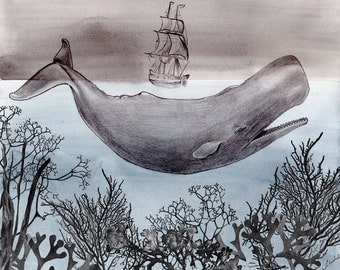the Blue whale needs your help
By: Alexa Signore
About Blue whales:
Population changes:
The total population of Blue whales has been depleted by 70%. The main cause for the near extinction of Blue whales can be attributed to direct exploitation; whale hunting. About 360,000 whales were killed in the 20th century in the Antarctic alone. The chart below shows the population trends.| southern hemisphere | North Pacific | North Atlantic | |
| pre-whaling | ~175,000 | ~4,900 | ~1,300 |
| current | ~2,000 | ~2,500 | ~500 |
Despite this disheartening information, there is hope for recovery. The current population trend shows that Blue whale populations are increasing.
Major Threats to Blue whales:
The main reason that Blue whales were almost entirely wiped is due to commercial whaling, which is what caused them to be listed as endangered. Starting in the 1700s, whaling became a profitable business and Blue whales were targeted for their large amounts of blubber and their body parts. The blubber and body parts were sold to suppliers that used them for making various materials such as oil, food, and clothing. The International Whaling Commission granted worldwide protection of Blue whales in 1966, however they continued to be caught illegally until the last recorded catches occurred in 1978 off Spain. Blue whale populations in our world's oceans are now only a fraction of what they once were pre-whaling.Although the main threat causing Blue whales to be listed was commercial whaling, and Blue whale populations have been on the rise since being protected under the Endangered Species Act, they still face some other possible threats. The most obvious potential indirect threats are collisions with vessels, entanglement with fishing gear, reduced zooplankton due to habitat degradation, areas degraded by chemical pollution, and disturbance by acoustic pollution from ships. There is also the potential of the long term threat of climate change. According to the IUCN Red List, it is expected that during this century there will be a huge reduction in the extent of sea ice in the Antarctic. We can't be sure of the implications of this for blue whale, however it is still an issue that warrants monitoring.
Addressing the Problem
In 1970 the Blue whale was listed as endangered under the Endangered Species Conservation Act which became the Endangered Species Act in 1973 and is listed as "depleted" throughout its range under the Marine Mammal Protection Act. Through knowledge of what the main threats to the Blue whale's continued existence are, a recovery plan was implemented July of 1998 in aims to ensure that these great creatures roam our oceans for centuries to come. The key recommended actions of the proposed recovery plan are:
2) estimate population size & monitor trends in abundance
3) identify & protect essential habitats
4) minimize or eliminate human-caused injury & mortality
5) coordinate state, federal, & international actions to implement recovery efforts
6) determine & minimize any detrimental effects of directed vessel & aircraft interactions
7) maximize efforts to acquire scientific information from dead, stranded & entangled animals"
Check out this video showcasing these amazing creatures!
How I plan to Help and How You Can Join Me:
Works cited:
"Blue Whale." WWF -. N.p., n.d. Web. 22 Nov. 2015.
"Support the." Balaenoptera Musculus (Blue Whale, Pygmy Blue Whale, Sibbold's Rorqual, Sulphur-bottom Whale). N.p., n.d. Web. 22 Nov. 2015.
By, Prepared, Randall R. Reeves, Phillip J. Clapham,, Robert L. Brownell, Jr., And Gregory K. Silber, and For The. RECOVERY PLAN FOR THE BLUE WHALE (n.d.): n. pag. Web.
"STW - Blue Whale." STW - Blue Whale. N.p., n.d. Web. 22 Nov. 2015.
"Blue Whale - Endangered Species Listing." Blue Whale. N.p., n.d. Web. 23 Nov. 2015





This comment has been removed by the author.
ReplyDeleteLoved your blog! You incorporated some awesome visuals like the beginning meme as well as a very informative video. You even listed several ways to help the Blue Whale that won't be difficult for me to accomplish. Great job! Save the Blue Whales!!
ReplyDelete#BIO227Fall2015